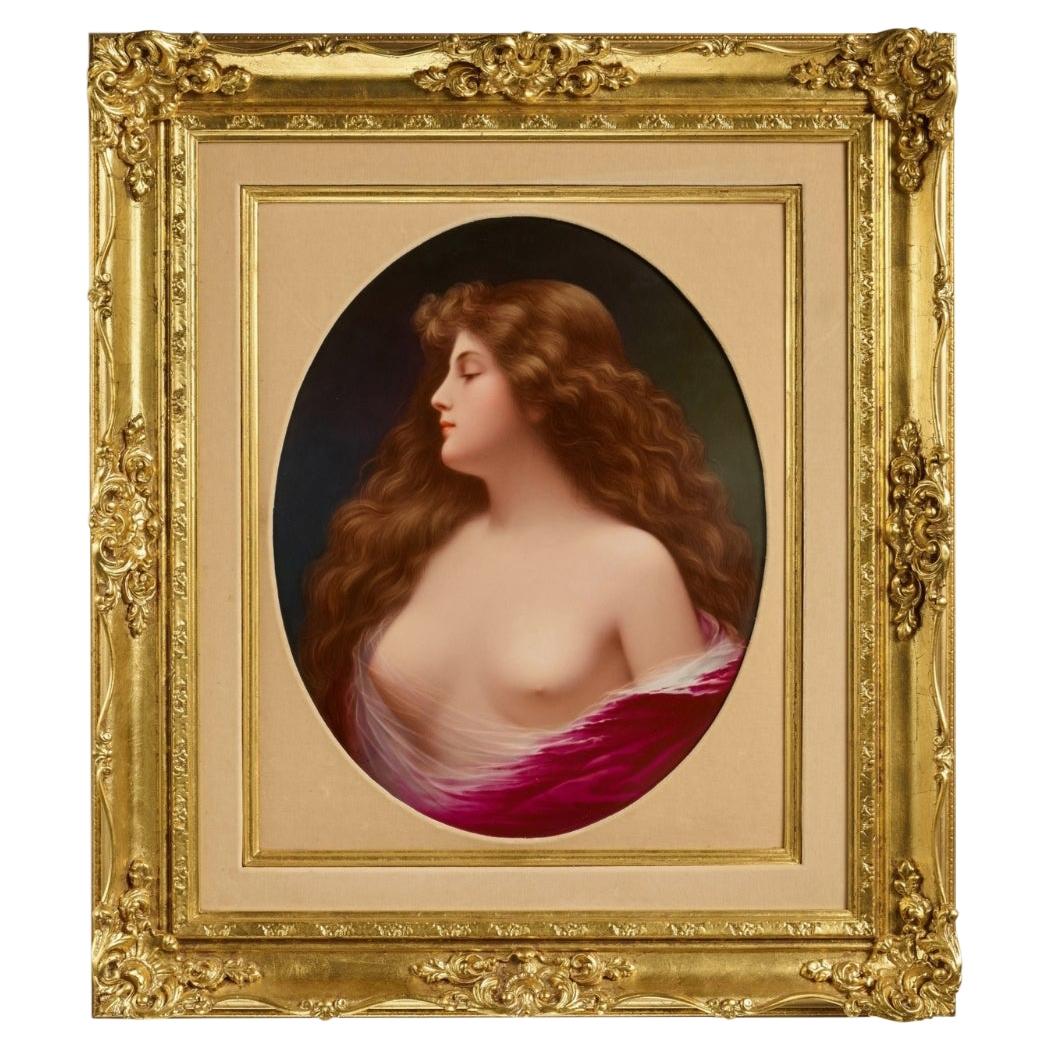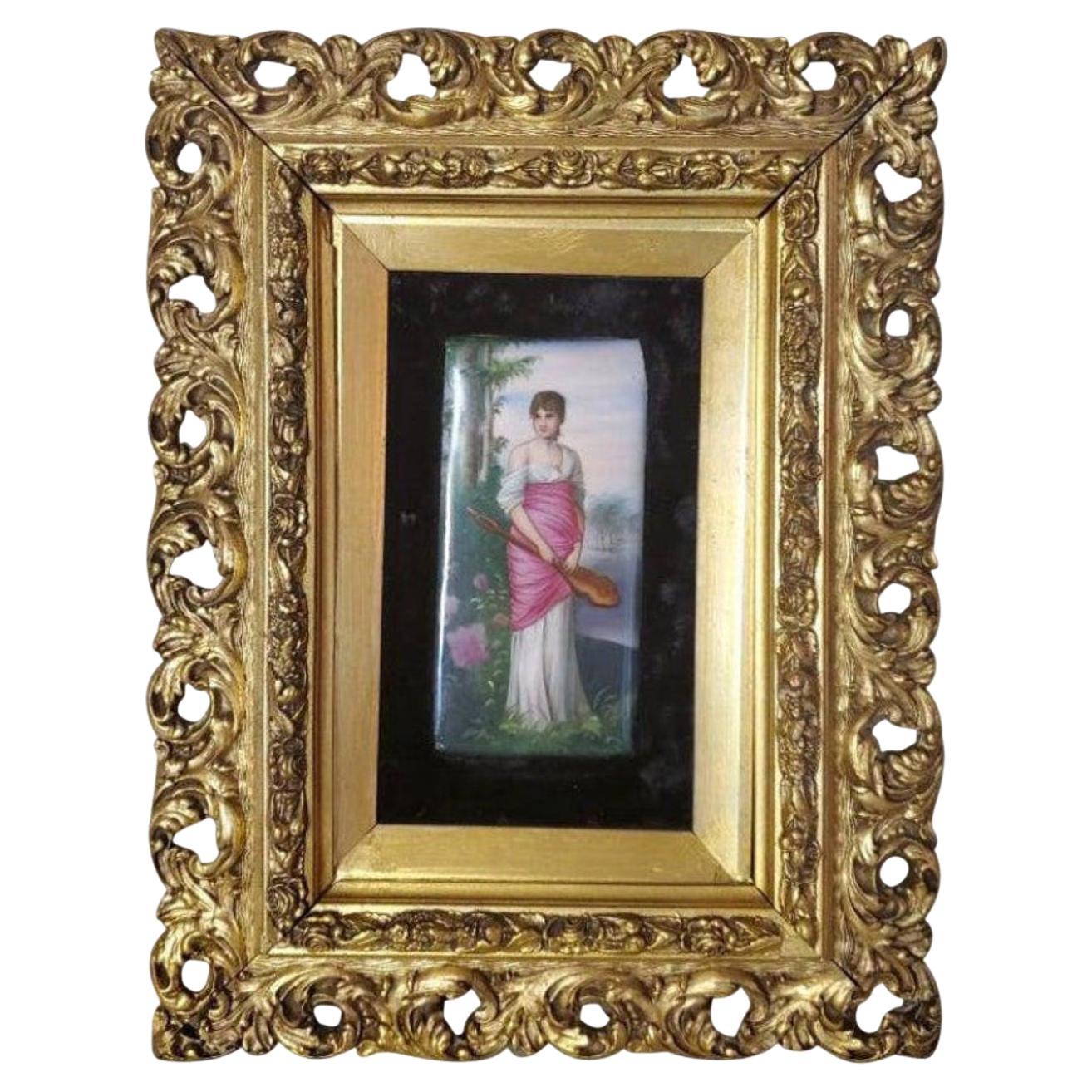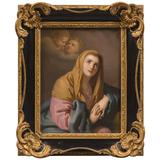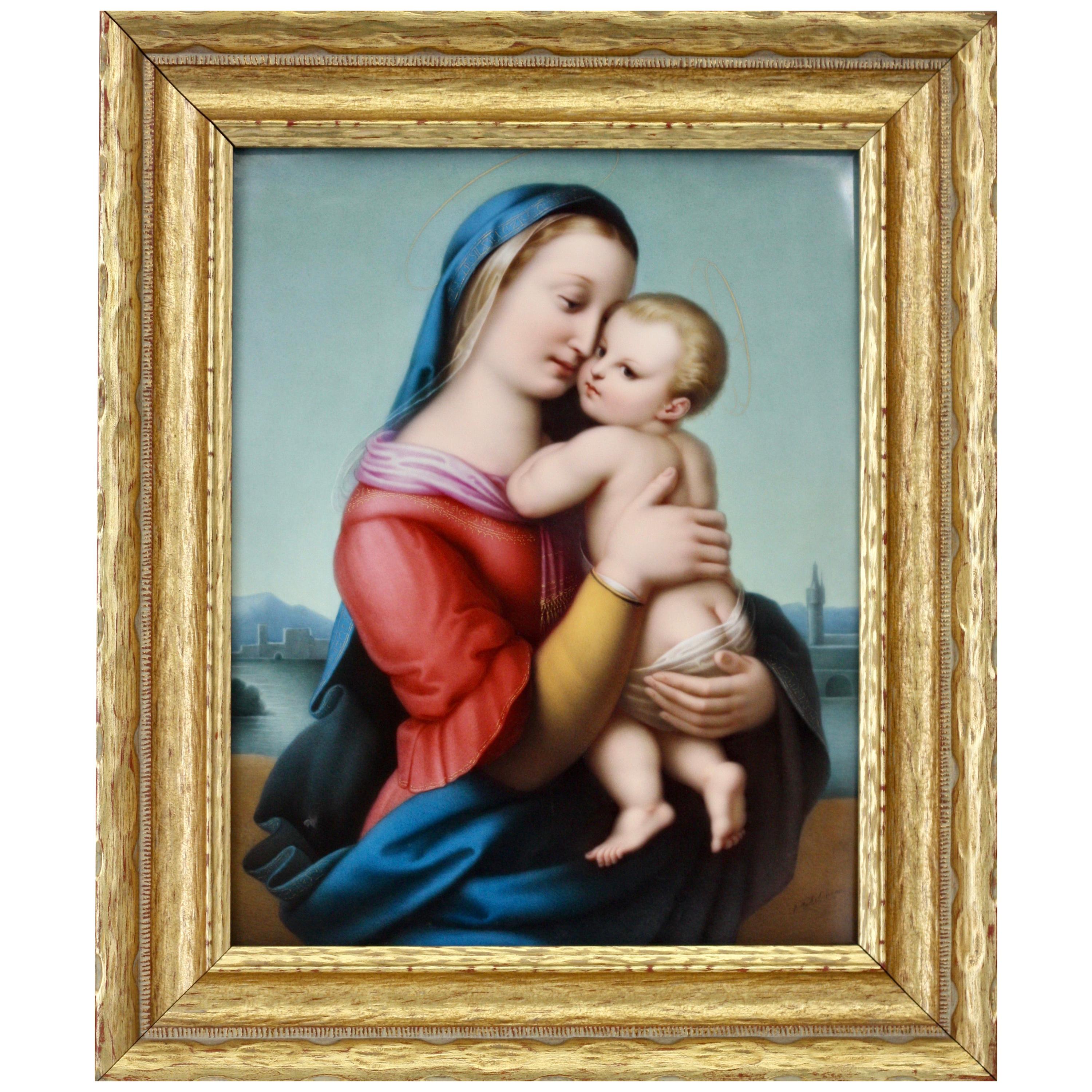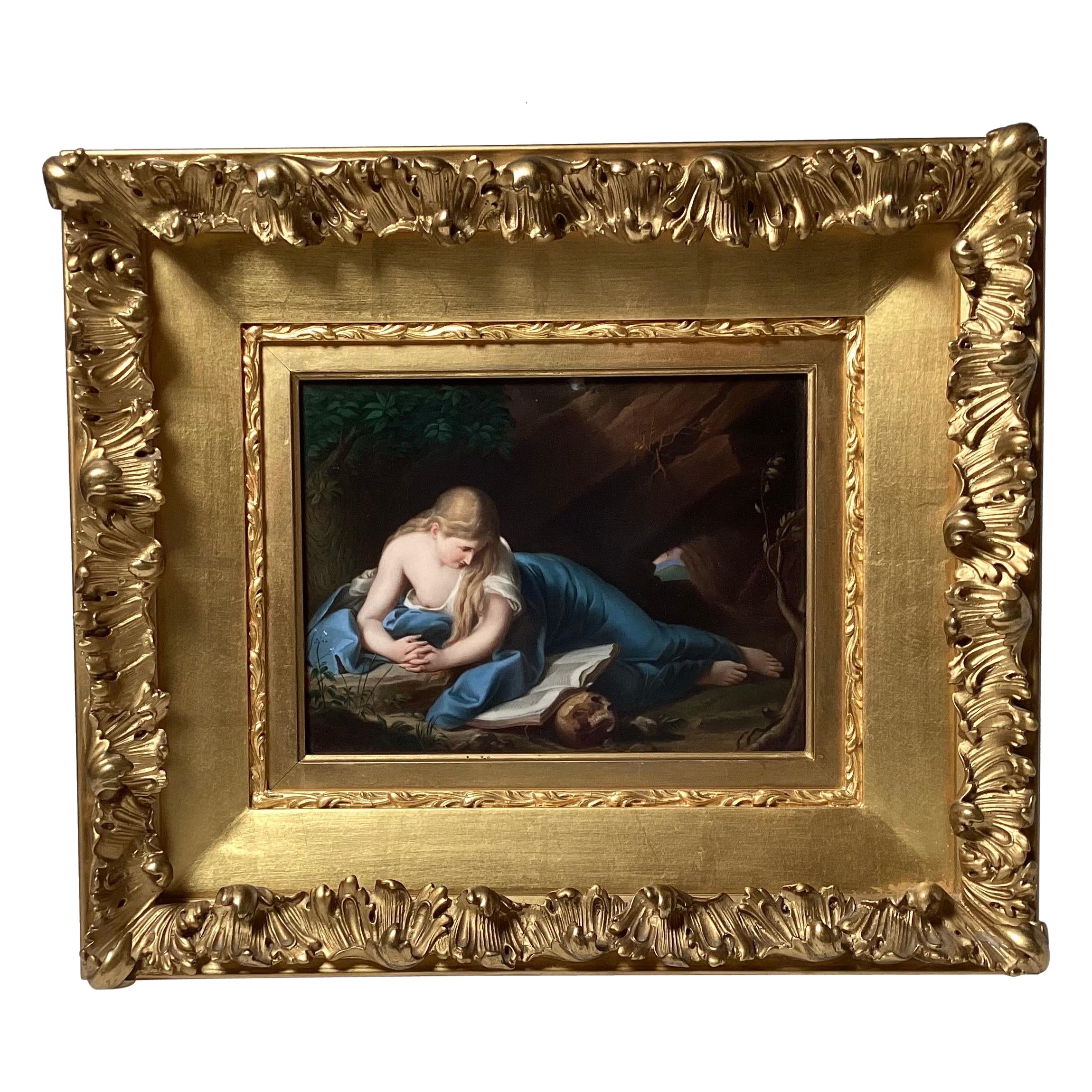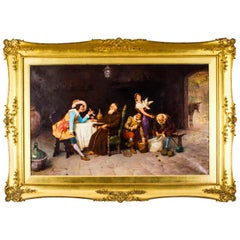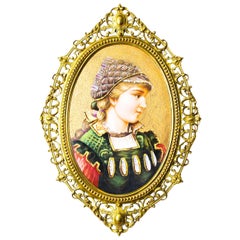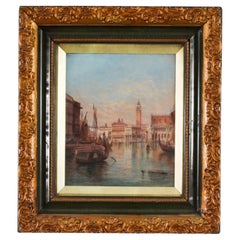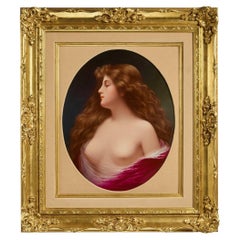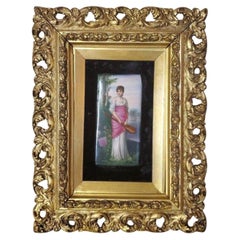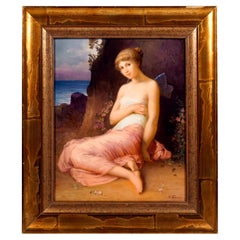Items Similar to Antique Berlin KPM Plaque 'KUNST BRINGT GUNST On Stand 19th Century
Video Loading
Want more images or videos?
Request additional images or videos from the seller
1 of 22
Antique Berlin KPM Plaque 'KUNST BRINGT GUNST On Stand 19th Century
About the Item
This is an absolutely stunning and finely painted KPM Berlin Plaque after Paul Thumann's (1834-1908) 'Kunst Bringt Gunst' (meaning 'Art wins heart'), signed Knouller and raised on a decorative gilt bronze easel stand, circa 1880 in date.
This magnificent plaque is portrait in shape and depicts a candid young girl watching a graceful Greek artist while he is decorating a pottery vase. The young artisan is painting a black figure on the surface of the amphora while she is standing tall at the doorway and watching him.
Both figures dress in classical clothes and are set within a nostalgic environment reminiscent of antique ruins and of a paradisiac landscape. Indeed, a sweet and almost melancholy calm prevails. The original painting by the German artist, Thumann, just like many other of his romantic paintings, became very popular and was widely reproduced on porcelain plaques, plates and vases.
This truly splendid plaque is signed to the left bottom corner 'Knouller' and bears the impressed sceptre mark for KPM and comes with a Rococo style bronze stand.
It is set in its original splendid gilt frame displaying foliate decorations to the border and riased on a decorative gilt bronze easel stand.
Add this splendid antique plaque to a very special wall in your home.
Condition:
The plaque, the gilded frame and the easel are all in excellent condition, please see photos for confirmation.
Dimensions in cm:
Height 24 cm x Width 18 cm x Depth 2.5 cm - Framed Plaque
Height 43 cm x Width 20 cm x Depth 16 cm - Easel Stand
Dimensions in inches:
Height 9 inches x Width 7 inches x Depth 1 inch - Framed Plaque
Height 1 foot, 5 inches x Width 8 inches x Depth 6 inches - Easel Stand
The Royal Porcelain Factory in Berlin (German: Königliche Porzellan-Manufaktur Berlin, abbreviated as KPM), also known as the Royal Porcelain Manufactory Berlin and whose products are generally called Berlin porcelain, was founded in 1763 by King Frederick II of Prussia (known as Frederick the Great). Its actual origins, however, lie in three private enterprises which, under crown patronage, were trying to establish the production of "white gold" (i.e. porcelain) in Berlin from the mid-18th century onwards.
Before KPM was founded, two attempts had already been made to establish a porcelain manufactory in Berlin. In 1751, the Berlin wool manufacturer Wilhelm Caspar Wegely was granted the royal privilege to set up a porcelain manufactory in Berlin. Furthermore, Frederick II of Prussia granted him exemption from duties for the import of essential materials and assured him of the exclusion of all competition.
Wegely hired first-class craftsmen from his competitors, and appointed the porcelain sculptor Ernst Heinrich Reichard to the post of chief modeller. However, technical difficulties and the Seven Years' War between Prussia and Saxony soon proved to be the enterprise's downfall. In 1757, he dissolved his company and sold its inventories, equipment and materials to the Berlin businessman Johann Ernst Gotzkowsky.
In 1761, the second porcelain manufactory in Berlin started its operations. Gotzkowsky concluded an agreement with Wegely's chief modeller, Ernst Heinrich Reichard, who was in possession of the secret formula known as the arcanum. Reichard received 4,000 thaler for the arcanum, and another 3,000 for the stock of porcelain and other materials. Furthermore, he undertook to work for Gotzkowsky as a keeper of the arcanum and as the manager. Gotzkowsky also agreed to take over Reichard's eight workers.
Appreciated and supported by the King of Prussia, Gotzkowsky managed to attract important artists and qualified employees. Right at the start, Gotzkowsky appointed Friedrich Elias Meyer, a pupil of Johann Joachim Kändler who came from Meissen, to the post of chief modeller, and Carl Wilhelm Boehme to the post of head of the porcelain-painting department. Gotzkowsky bought another building next to his own property at Leipziger Straße 4, and he began to build a manufactory on the site.
Nevertheless, Gotzkowsky's finances began to deteriorate. Since the royal exchequer was in the red on account of the war, Gotzkowsky believed that he stood little or no chance of obtaining assistance from the king. The end of the war also signalled the end for Gotzkowsky's manufactory.
Today, the porcelain pieces from the early days marked with a W for Wegely und a G for Gotzkowsky are extremely rare and highly coveted collector's items.
On 19 September 1763, Frederick II officially became the manufactory's new owner. He purchased the manufactory for the considerable sum of 225,000 thaler and took over the staff of 146 workers. He gave the business its name and allowed it to use the royal sceptre as its symbol. From then on, it was called the Königliche Porzellan-Manufaktur Berlin ("Royal Porcelain Manufactory Berlin") and became a model of how to run a business. There was no child labour, there were regular working hours, above-average incomes, secure pensions, a healthcare fund and assistance for widows and orphans.
In 1784, after a four-year development period, the king's desire for a soft and delicate shade of blue was fulfilled. The colour was known as Bleu mourant ("dying blue"), and it was used to decorate Neuzierat, Frederick's favourite dinner service. The colour was predominant in the king's private chambers at Sanssouci Palace and in the blue chamber of the New Palace in Potsdam, as well as in other castles.
As owner of KPM, the king used the "white gold" as an effective means of diplomacy. Almost all of his diplomatic presents came from the manufactory, and they were to be found at the court of the tsars in Russia and on the tables of European aristocracy. Under Frederick the Great's successor, his nephew Frederick William II, the manufactory became a technologically leading enterprise. The new king obtained what he needed in the way of porcelain from KPM, but stopped paying cash. The amounts due were deducted from his share of the profits. The manufactory flourished. From 1787 onwards, the average annual net profit came to more than 40,000 thaler.
Our reference: A1094b
About the Seller
5.0
Platinum Seller
Premium sellers with a 4.7+ rating and 24-hour response times
Established in 1983
1stDibs seller since 2012
1,341 sales on 1stDibs
Typical response time: 1 hour
Associations
LAPADA - The Association of Arts & Antiques Dealers
- ShippingRetrieving quote...Shipping from: London, United Kingdom
- Return Policy
Authenticity Guarantee
In the unlikely event there’s an issue with an item’s authenticity, contact us within 1 year for a full refund. DetailsMoney-Back Guarantee
If your item is not as described, is damaged in transit, or does not arrive, contact us within 7 days for a full refund. Details24-Hour Cancellation
You have a 24-hour grace period in which to reconsider your purchase, with no questions asked.Vetted Professional Sellers
Our world-class sellers must adhere to strict standards for service and quality, maintaining the integrity of our listings.Price-Match Guarantee
If you find that a seller listed the same item for a lower price elsewhere, we’ll match it.Trusted Global Delivery
Our best-in-class carrier network provides specialized shipping options worldwide, including custom delivery.More From This Seller
View AllAntique Porcelain Plaque in Gilded Frame of Abraham 19th Century
By Berlin Royal Porcelain Factory
Located in London, GB
This is a magnificent and finely painted porcelain plaque, probably Berlin, finely painted with a portrait of Abraham expelling Hagar and her son, in a stunning giltwood frame.
The...
Category
Antique 19th Century German Paintings
Materials
Porcelain, Giltwood
Antique Oil on Canvas Painting by Francesco Bergamini 19th Century
By Francesco Bergamini 1
Located in London, GB
This is a truly splendid antique oil on canvas painting featuring a period interior scene by Francesco Bergamini (1851-1900) Italian, signed and dated 1894.
This beautiful oil pai...
Category
Antique 1890s Italian Paintings
Materials
Canvas, Giltwood
Antique Berlin Oval Porcelain Plaque Young Woman Ormolu Frame, 19th Century
Located in London, GB
This is a stunning and unique antique Berlin framed porcelain plaque, circa 1870 in date.
This magnificent plaque is oval in shape with an ...
Category
Antique 1870s German Porcelain
Materials
Ormolu
Antique Oil on Canvas Painting of Venice by Alfred Pollentine 19th Century
By Alfred Pollentine
Located in London, GB
This is a beautiful oil on canvas painting of the view of the The Grand Canal in Venice by the renowned British artist Alfred Pollentine (1836-1890) and signed lower right, 'A Pollen...
Category
Antique 1870s Paintings
Materials
Canvas
Antique Waterscape Oil Painting by William Dommersen 19th Century
Located in London, GB
A beautiful waterscape painting " A view on the Amstel " by William Raymond Dommersen (British, 1859-1927) Signed, Signed with initials, and Inscribed on reverse, late 19th Century in date.
The painting has a captivating illuminating light with beautiful vibrant colours, it depicta a busy waterway with fishing and sailing boats in the foreground and the town of Amsterdam in the back ground.
William Raymond Dommersen was a painter of genre and landscapes in and around Scotland and Northern England. His works are widely exhibited throughout the European and North American continents and are on show at many galleries worldwide.
William travelled quite extensively in Europe on painting expeditions with his father
Dommersen’s paintings have been much admired over a period of time and it is evident that he is now firmly established in the history of architectural painting as is refelected in the auction prices at Christies:
Nineth century European Art: 12 September 2007, London South Kensington, Lot 29 £4,750
The Arthur Ackermann and Peter Johnson Collection: 8 May 2008, London, South Kensington, Lot 42, £4,000
Old Masters and 19th Century Art 9 November 2010, Amsterdam, Lot 110 £5,250
Nineth century European Art: 28 April 2010, London South Kensington, Lot 221 £5,250
Condition:
In really superb condition the painting and frame having been beautifully cleaned, please see photos for confirmation.
Dimensions in cm:
Height 59 x Width 50 x Depth 7 - Frame
Height 34 x Width 44 x Depth 7 - Canvas
Dimensions in inches:
Height 1 foot, 11 inches x Width 1 foot, 8 inches x Depth 3 inches - Frame
Height 1 foot, 1 inch x Width 1 foot, 5 inches x Depth 3 inches - Canvas
William Raymond Dommersen
was born at the end of 1859 in Stratford, West Ham, London as the only son of the Anglo / Dutch fine art painter Pieter Cornelis Dommersen and Anna Petronella Synja. His parents had moved from the Netherlands in 1855 to London, England. His uncle, Cornelis Christiaan Dommersen, was also a painter in the Netherlands. It is possible that when his father received British nationality that they changed their family name – van Dommershuijsen – into the more English sounding surname Dommersen.
Dommersen painted between 1875 and 1927 genre pieces, landscapes, marine scenes, village- and town-scenes of quality. His best known works are the European villages and towns along rivers and canals...
Category
Antique 1890s British Paintings
Materials
Canvas
Antique Painting Madonna & Child 'Paoletti and Ferretti' 19th Century
Located in London, GB
This is a beautiful oil on canvas painting after Raphael, depicting the Madonna and Child in the original giltwood Florentine frame, Circa 1880 in date.
It bears a label to the reve...
Category
Antique 1880s Paintings
Materials
Giltwood
You May Also Like
'Erblüth' a Large 19th Century Berlin 'KPM' Porcelain Plaque
By Königliche Porzellan-Manufaktur (KPM)
Located in Brighton, West Sussex
'Erblüth' a large and very fine Berlin (KPM) Porcelain plaque, after Angelo Asti. In a giltwood and composition shadow box frame.
Signed 'Weigel', impr...
Category
Antique 19th Century German Paintings
Materials
Porcelain, Giltwood
19th Century KPM Berlin Painted Porcelain Plaque, Die Lautenspielerin
By KPM Porcelain
Located in Forney, TX
A late 19th century Berlin KPM painted porcelain plaque, Die Lautenspielerin, in pierced foliate giltwood frame, painting after Friedrich August von Kaulbach (German, 1850-1920). Mod...
Category
Antique Late 19th Century Victorian Paintings
Materials
Porcelain, Giltwood, Paint
Large 19th Century Berlin Rectangular KPM Porcelain Painted Framed Plaque
By KPM Porcelain
Located in Los Angeles, CA
A large 19th century Berlin Rectangular K.P.M porcelain painted framed plaque
Germany, circa 1880
Very well painted depicting a women draped in linens with two angels above h...
Category
Antique 1880s German Napoleon III Paintings
Materials
Porcelain
KPM Berlin Porcelain Plaque 'Psyche' after Wilhelm Kray, Germany, 19th Century
By KPM Porcelain
Located in Vienna, AT
Delicate Porcelain Painting In Gilded Frame:
Exquisite depiction of a young, beautiful girl with her hair tied up and delicate, translucent wings, wrapped in fine, flowing pink and w...
Category
Antique Late 19th Century German Romantic Porcelain
Materials
Wood, Porcelain
Berlin KPM Porcelain Plaque Last Quarter of the 19th Century after Raphael
By KPM Porcelain
Located in West Palm Beach, FL
A Berlin KPM Porcelain Plaque
Last quarter of the 19th century
After Raphael,
depicting Madonna and child with a river and city in the distance, signe...
Category
Antique 19th Century Paintings
Materials
Porcelain
$14,400 Sale Price
20% Off
A 19th Century KPM Porcelain Plaque of Mary Magdalene
By KPM Porcelain
Located in Lambertville, NJ
A beautifully painted porcelain plaque in original giltwood frame. The image of Mary Magdalene after the original Italian artist, Pompeo Batoni. The measurements framed are 16 inch...
Category
Antique 19th Century German Paintings
Materials
Porcelain, Giltwood
